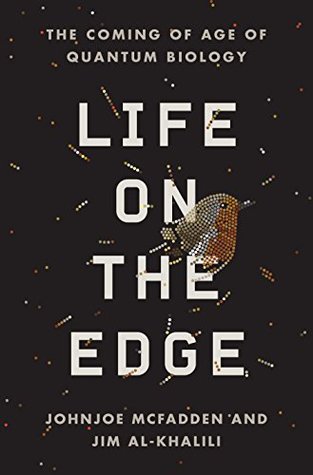More on this book
Community
Kindle Notes & Highlights
Read between
August 13, 2024 - August 26, 2025
Life appears to have one foot in the classical world of everyday objects and the other planted in the strange and peculiar depths of the quantum world. Life, we will argue, lives on the quantum edge.
Aristotle claimed that living creatures, unlike inanimate objects, were capable of initiating their own motion, and that in this case the cause of such motion was the creature’s soul.
Many biologists experience similar bemusement when, despite knowing how thermodynamics operates in living cells and how genes encode everything that is required to form the cell, the mystery of what life really is continues to grin back at them.
No one has ever discovered a condition that favors the direction: dead cell → live cell. This was of course the puzzle that prompted our ancestors to come up with the idea of a soul. We no longer believe that a cell possesses any kind of soul; but what is it then that is irrevocably lost when a cell or a person dies?
The Nobel Prize–winning physicist Richard Feynman is credited with insisting that “what we can’t make, we don’t understand.” By this definition, we do not understand life because we have not yet managed to make it.
The finite number of frets means that only certain, discrete, notes can be played on the guitar. Adjusting the position of the finger between two frets will not alter the note when that string is plucked. The guitar is thus akin to a quantum instrument. And since, according to quantum theory, frequency and energy are related, the vibrating guitar string must possess discrete, rather than continuous, energies.
But life, he argued, was different, because it was ruled by a very few molecules within the Steuerungszentrum that have a dictatorial influence, such that quantum-level events that govern their motion, such as Heisenberg’s Uncertainty Principle, are amplified to influence the entire organism.
The collagenase enzyme that Mary Schweitzer added to her dinosaur bones is just one of these biomachines whose regular job in animal bodies is to disintegrate collagen fibers. The rate of speed-up provided by enzymes can be roughly estimated by comparing the time taken to digest collagen fibers in their absence (clearly, more than sixty-eight million years) and in the presence of the right enzyme (about thirty minutes): a trillion-fold difference.
de Réaumur was puzzled by how birds of prey, whose gizzards lacked digestive stones, also managed to digest their food. So he fed his pet falcon small pieces of meat enclosed in tiny metal capsules punctured by small holes. When he recovered the capsules he discovered that the meat was completely digested, despite the fact that, protected within the metal, it could not have been subject to any mechanical action.
the chemist Eduard Buchner, demonstrated that nonliving extracts from yeast cells could stimulate precisely the same chemical transformations brought on by the live cells. Buchner went on to make the revolutionary proposal that the vital force was nothing more than a form of chemical catalysis.
Indeed, it is our view that the quest to understand this strangest of biological phenomena is often hindered by a persnickety insistence on defining it. Biologists cannot even agree on a unique definition of life itself; but that hasn’t stopped them from unraveling aspects of the cell, the double helix, photosynthesis, enzymes and a host of other living phenomena,
But consciousness is different. Nobody knows where or how it fits in with the kind of science that we have discussed so far. There are no (reputable) mathematical equations that include the term “consciousness,” and unlike, say, catalysis or energy transport, it has not, so far, been discovered in anything that isn’t alive.
This compression of complex information into a singular idea was noted in a description attributed to Mozart of how an entire musical composition might be “finished in my head though it may be long. Then my mind seizes it as a glance of my eye … It does not come successively, with various parts worked out in detail, as they will be later on, but in its entirety.”3 The conscious mind is able to “seize” on complex information “with various parts” so that its meaning can be grasped “in its entirety.” Consciousness allows our mind to be driven by ideas and concepts, rather than mere stimuli.


